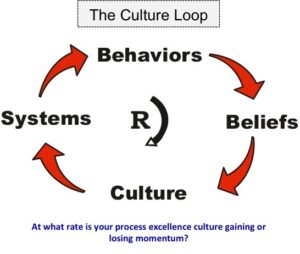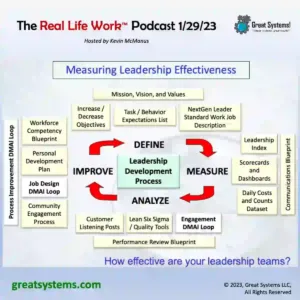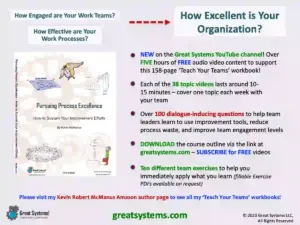This post explores ten different ways to change your work culture via work systems redesign.

10 Ways to Change a Work Culture
I’ve often heard it said that it takes five to seven years to change a work culture. My experience tells me otherwise. Unfortunately, many, if not most, culture change efforts do take much longer than is necessary. This is because of the approaches leaders use in an attempt to change the existing work culture. If you want to change a work culture, and change that culture relatively quickly, you have to fundamentally change the key work systems that created what you have now.
What do I mean by fundamental work systems change? Well, to help you gain a better perspective of what I mean, here is a list of ten key things that you can do right now. I have personally seen the impact these changes make. I am confident that if you give at least a few of them a try, you too will begin see a noticeable difference in a short amount of time.
Change Work Systems to Shift Work Cultures
Most importantly, keep this in mind. You will not be able to sustain a lean six sigma, operational excellence, or process excellence pursuit if you don’t make a culture change first (unless you start from scratch and design your systems to support such efforts from the start). Also, you cannot simply buy new tools, send people to training, or ask them to change and change a culture. If you want to change your work culture, you have to change the work systems that created that culture in the first place, and have been shaping it every day since that point in time.
DISCOVER MORE: How Great are Your Work Systems?
Tip #1 – Change Your Hiring Process
The beliefs and work practices that your work teams demonstrate daily define your work culture. Does the design of your current hiring process fail to attract, identify, and retain people who think and behave in a manner that is consistent with the culture you desire? If so, you only move further away from your culture change goals with each new hire decision that is made.
Who do you involve in your work team selection process? What types of questions do they ask? How do you make your final personnel selections? What sources do you use to find people? How do you know when you hire people that will support and promote the work culture that you desire?
LEARN MORE: How to Measure and Improve Your Job Design Work System
Tip #2 – Measure Leadership Behavior Consistency
Most organizations measure leadership effectiveness in a very general and vague manner. Very few measure leadership behavior consistency. Ideally, we should measure leaders by the personal contributions they make. Instead, we usually focus on the results their work teams obtain. More importantly, you should measure the degree to which EACH leader consistently models the types of behaviors needed to support your desired culture.
For example, it is one thing to say that you want your leaders to empower their people and value their input. It is quite another thing to actually measure the degree to which your leaders do this day in and day out. Measure leadership behavior consistency and take action to help your leaders improve their scores. Reassign those people who aren’t able to meet these expectations after a year or so. Don’t allow certain leaders to continue to behave badly.
EXPLORE MORE: Measuring Leadership Behavior Effectiveness
Tip #3 – Use Balanced Scorecards on All Processes
Most organizations that use balanced scorecards only use them at the organizational level. Very few ensure that a balanced set of performance measures are in use for each key process. Also, they fail to show their work teams how to use these scorecards to effectively review and improve performance. They might create the scorecard, but how do they review performance against it?
Often, they continue to focus more on throughput, pieces made, or sales volume to a much greater degree than the other card measures. High performance organizations require ALL work team leaders (managers, supervisors, etc.) to consistently improve the trends for all of their key measures, not just those that have been culturally popular to focus on in the past. How effectively do your measurement systems support the work culture you desire?
DISCOVER MORE: LISTEN to my ‘Explore My Measurement Madness’ Real Life Work podcast!
Tip #4 – Improve Your Communication Methods and Systems
The prevailing communication system in most organizations is infrequent and one-way in nature. In other words, work teams don’t get a lot of information or feedback about how they perform or how the organization performs. When they do, this information is more often negative, than not. The net results of this cultural commonality is that most employees see the existing meetings, newsletters, and bulletin board postings as a waste of time, whether you are aware of this or not.
I’ve even seen organizations do more damage than good in their attempts to inform people because of the type of information they share (and don’t share), and how they chose to share it. Coordinate the different group events that you have, measure event effectiveness, and take action to make necessary improvements.
LEARN MORE: Do You Know How to Reduce Meeting Waste?
Tip #5 – Change Your Compensation System
I don’t believe money is as much of a motivator as it is a demotivator. If your people perceive that your current compensation system is not fair, it will affect their attitudes, and in turn, their behaviors. Your compensation system affects the degree to which your people bring up problems to their supervisors. It affects their willingness to assist with process improvement efforts, provide excellent customer service, and detect product or service defects.
People consistently evaluate what they, and others, get in terms of wages, benefits, and work environment attributes against the daily efforts they make. In many cases, their perceptions are exaggerated. In other cases, inconsistency and inequity justify their perceptions. By moving towards a more equitable compensation system that rewards people for supporting the desired work culture, a major roadblock in your culture change effort can be removed.
Tip #6 – Expect Different Things from All of Your Leaders
Are all of your leaders skilled at using process improvement tools? To what degree do each of your meeting leaders effectively facilitate and manage the group dynamics of their work teams? How many of your leaders can use spreadsheets, word processing software, and web page development tools in an effective manner? Do you even think that these skills should be required of people in leadership roles?
All of your leaders – not just the people at the top – play the most significant role in shaping your work culture. If you want to change your work culture to a great degree in a short amount of time, you need change how all of your leaders spend their time and behave each day on the job.
Most organizations ask, or tell, their leaders that they need to change. Few take the necessary actions to ensure that new skills are learned and practiced regularly, or that desired behaviors are developed and displayed in the workplace each day. What do you expect of your leaders?
How do you measure the degree to which these expectations are being consistently met? How will you change each leadership job description, performance review approach, and compensation practice to reinforce the work practices that are needed for culture change to occur?
EXPLORE MORE: How to Measure and Improve Your Leadership Work System
Tip #7 – Measure Internal Customer Satisfaction
Some organizations don’t measure and trend internal customer satisfaction at all. Those that do tend to do it only once a year at best. However, high performance organizations regularly trend and review multiple indicators of staff satisfaction. Examples include staff retention rates, customer complaint levels, and internal satisfaction (perception survey) scores. Do you want to change your existing work culture? If so, you must assess the degree that your people feel that your current work systems and habits support such a change.
Plus, you need a gauge of where your work culture currently stands. What do your people think and believe about the organization? Try to review these measures monthly. As you do, identify possible system changes (such as those I mention here) to affect those scores. Then, take action to put the highest priority system changes in place. Don’t forget to identify and remedy the sources of internal customer dissatisfaction as well.
LEARN MORE: How to Measure and Improve Your Customer Satisfaction Work System
Tip #8 – Eliminate Non-Value Added Process Activities
The use of lean tools and concepts by work teams in organizations is very popular right now. Unfortunately, few organizational leaders use these tools on their own work processes. For example, do you measure and trend meeting effectiveness? Have you taken steps to make your decision making processes leaner? Does each work team leader in your organization have plans that minimize the non-value added activities that exist in those key processes they are personally responsible for?
Hypocrisy holds back a high performance work culture as much as anything. You can’t begin to move your culture forward if systems remain in place to hold it back. Leaders need to remove waste from all key work processes, not just those that hourly people perform. As with hypocrisy, ‘Leader Standard Waste’ kills a culture change effort.
DISCOVER MORE: Process Improvement Strategies
Tip #9 – Use Technology as an Improvement Catalyst
Most organizations attempt to utilize new technologies. However, few achieve the degree of success that they should. The primary challenge in realizing this potential lies in the fact that most members of upper management are ‘before computers’ people. They began their work career before computers were in the mainstream. In turn, their perspective of the power of a digital workplace are short sighted.
In most cases, their attempts to use e-mail, intranets, and video conferences to help the organization only scratch the surface when it comes to effective technology use. Each work team leader’s goal should be to reach more people with a more powerful message. Technology use should help collect more information from more customers in a low cost manner.
Instead, technology use results in more time waste via ineffective meetings. Little gain in decision speed or accuracy occurs. Slow typing, redundant report generation, and speedy, but often counterproductive, feedback add further to the Leader Standard Waste stream list.
LEARN MORE: How to Measure and Improve Your Technology Utilization Work System
Tip #10 – Stop Doing Things That Run Counter to the Culture You Desire
Each day, your work culture moves closer to, or further away from, the type of culture that you desire. Cultures are a system in themselves. They have momentum. Plus, they spin in either in a negative or positive direction. Your work systems reinforce both desired and undesired work habits every day. Until you recognize this, you won’t be motivated to identify and change those systems that reinforce those things that you don’t really want to reinforce.
In the above nine tips, I give you some examples of ineffective work systems. I hope that you take the time to reflect on the degree to which similar examples might be in place in your organization. More importantly, should you find such systems in place, I hope that you begin to take actions to upgrade them. If you do so, your ‘new’ work systems will reinforce the right beliefs and behaviors, instead of the wrong ones.
EXPLORE MORE: Workplace Safety Best Practices
How Value Added are Your Culture Change Efforts?
I wrote my ‘how to develop a high performance work culture’ book to help companies stop time and money waste as they try to change their cultures in unproductive ways. Most organizations try to change their work cultures by hiring consultants, sending people to training sessions, asking their leaders to manage differently, and forming teams that may only last a year or two. In some cases, these approaches might have some impact.
Unfortunately, the shift usually takes a lot longer than it should. Today’s high performance organizations use more effective approaches to develop and sustain the work culture they desire. I describe many of these approaches in the book. However, I also give a lot of these ideas away for free here on this website.
Do you want different results (a new and improved work culture)? If so, you must change the systems that created, and currently reinforce, the work culture you have in place. Also, significant emotional events, such as the loss of a major customer, an acquisition, or the threat of a facility closure, can change a culture. However, one rarely wants to go through such an experience in order to make this happen. Instead, learn from the organizations that have built and sustained high performance work cultures.
Keep improving!
Kevin McManus, Chief Excellence Officer, Great Systems
WATCH over 50 kaizen and workplace health improvement videos on my Great Systems YouTube channel.
CHECK OUT my ‘Teach Your Teams’ workbooks on Amazon.com
LIKE Great Systems on Facebook
© Copyright 2024, Great Systems LLC, All Rights Reserved





